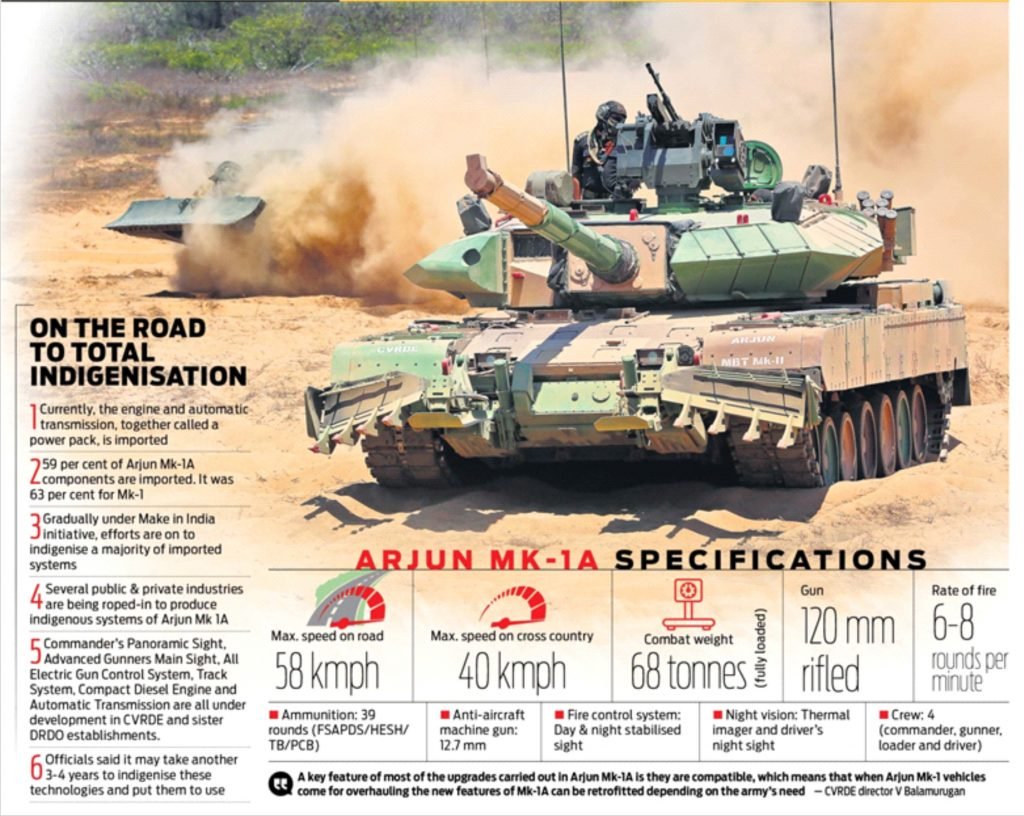Current Affairs (15th February 2021)
Arjun Main Battle Tank MK-1A
CONTEXT:
- Prime Minister handed over the indigenously developed Arjun Main Battle Tank (MK-1A) to the Indian Army at a ceremony in Chennai.
- The army will get 118 units of the Main Battle Tank, indigenously designed, developed and manufactured by CVRDE and DRDO along with 15 academic institutions, eight labs and several MSMEs.
What is the Arjun Main Battle Tank?
- Initiated by DRDO in 1972 with the Combat Vehicles Research and Development Establishment (CVRDE) as its lead laboratory.
- Objective : To create a “state-of-the-art tank with superior fire power, high mobility, and excellent protection”.
- Mass production began in 1996 at the Indian Ordnance Factory’s production facility in Avadi, Tamil Nadu.
Features
- The Arjun tanks stand out for their ‘Fin Stabilised Armour Piercing Discarding Sabot (FSAPDS)’ ammunition and 120-mm calibre rifled gun.
- Has a computer-controlled integrated fire control system with stabilised sighting that works in all lighting conditions.
- The secondary weapons include a co-axial 7.62-mm machine gun for anti-personnel and a 12.7-mm machine gun for anti-aircraft and ground targets.
Mk-1A
- Has 14 major upgrades on the earlier version.
- Have missile firing capability as per the design, but this feature will be added later as final testing of the capability is still on.
- The biggest achievement with the latest version is 54.3 per cent indeginous content against the 41 per cent in the earlier model.

Rare duck
CONTEXT:
- Rare Mandarin duckis floating in the Maguri-Motapungbeel (or wetland) in Assam’s Tinsukia district for over a week .
- First spotted on February 8, 2021, the duck has since become the star of the wetland — an area affected by a blowout and fire at a natural gas well located close by in May 2020.
About Duck
- Considered the most beautiful duck in the world, the Mandarin duck, or the (Aix galericulata) was first identified in 1758.
- The eBird website describes it as a “small-exotic looking bird” native to East Asia.
- The migratory duck breeds in Russia, Korea, Japan and northeastern parts of China.
- It now has established populations in Western Europe and America
- The duck, however, rarely visits India as it does not fall in its usual migratory route. There are only a handful of recorded sightings here.
- “It was recorded in 1902 in Dibruriver in the Rongagora area in Tinsukia”, “More recently, it was sighted in Manipur’s Loktak Lake in 2013, and in Saatvoini Beel in Manas National Park and Tiger Reserve in Assam’s Baksa district 2014.”
- While the duck is not a globally threatened species, spotting one is always considered significant because they only make “rare appearances.

Why in Assam?
- While birds usually follow a regular route for migration, it is also common for them to stray from the path.
- This is what possibly happened to the Mandarin duck, which was spotted at Maguribeel.
Maguribeel
- The Maguri Motapung wetland — an important Bird Area as declared by the Bombay Natural History Society — is located close to the Dibru Saikhowa National Park in Upper Assam.
- The wetland has a grassland adjacent to it. “The entire ecosystem (grassland and wetland) is very important as it is home to at least 304 bird species, including a number of endemic ones like Black-breasted parrotbill and Marsh babbler.”
Model contract farming law in 2018
CONTEXT:
- Between the Punjab Contract Farming Act 2013 and the Farmers (Empowerment and Protection) Agreement on Price Assurance and Farm Services Act 2020, another law on contract farming – the State/UT Agricultural Produce & Livestock Contract Farming and Services (Promotion & Facilitation) Act, 2018 – also known as Model act 2018 was legislated by the Union government.
- Around 20 states that had already amended their APMC Acts by 2016-17 under the provisions of the Centre’s Agricultural Produce Marketing Committee Act-2003, nearly 14 had notified the rules related to contract farming even before Model Act 2018 was notified.


Why did the government bring in the 2020 Act when Model Act-2018 was already in place for contract farming?
- Model Act 2018 is already in place, there was no need to bring the new law in 2020.
- Rather, some amendments could have been made to the earlier law to make it more farm-friendly.
- Then the government should have waited a few years to observe how the states were making or implementing the provisions of the law.
- Now the 2020 Act on contract farming will supersede the 2018 law. Keeping the 2018 law as base, some states had enacted own legislations on contract farming. Now, such laws will also stand null and void.
Similarities between the 2018 and the 2020 Acts
- The 2018 Act has provisions for the producer leasing out agricultural land to the sponsor – lessee, which is not legally inconsistent as of now.
- Both Acts link contract price to market price, which is the antithesis of contract farming philosophy. The reason for undertaking contract farming is that the desired quality of produce and at reasonable cost are not available to the agency in the open market. Now going back to the same mandi does not speak very well about the Act.
- In the 2018 Act, two-third of the value of the payment is to be made at the time of delivery (of crop), while the rest is to be done after the assessment of quality.
- In the 2020 Act, quality, grade, and standards for the pesticide residue, food safety, labour and social development standards may also be adopted in the agreement, but these aspects are only suggested and not made mandatory even though labour exploitation in contract farming is quite prevalent and also affects India’s export reputation in the global market fair trade and ethical products.
- Both the Acts suggest that a farming agreement may be linked with insurance or credit instruments under any scheme of the central or state government or any financial service provider to ensure risk mitigation and flow of credit to farmers or sponsor or both.
- In 2018 Act, Board, Dispute Resolution Authority and alternative measures were provided.
- As per the 2020 law, party may approach the concerned sub-divisional magistrate who shall be the sub-divisional authority for deciding the disputes under farming agreements.
- Any party aggrieved by the order of the SDM may prefer an appeal to the appellate authority, which shall be presided over by the collector or additional collector nominated by the collector, within 30 days from the date of such order.
- The 2018 Act provides for setting up of a Dispute Settlement Authority, an appeal in the Board and alternative dispute resolution mechanism. The 2020 Act provides SDM as an authority to settle disputes.
- The 2 laws say that there will be no action for recovery of dues against farmers’ land. But experts said that leasing of farm land is a crucial provision.
World Radio Day
CONTEXT:
- World Radio Day is observed on February 13 every year to celebrate one of the oldest and most widely consumed mediums of communication.
- The United Nations noted the important role that radio played during the Covid-19pandemic. The medium made it possible to “ensure continuity of learning, to fight against misinformation, and to promote barrier gestures”.
- It paid tribute to the medium and the way in which it has adapted to “societal transformations and listener’s new needs” for over a century.
History of World Radio Day
- First proclaimed by the member states of UNESCO in 2011 and later adopted internationally by the UN General Assembly in 2012.
- Objective : to promote the medium, increase accessibility, and encourage more people to use it.
- In India, the history of radio broadcasting traces back to August, 1920 when one of the first radio broadcasts was transmitted from the roof of a building.
- Three years later, the first radio programme was aired by the Radio Club of Bombay.
Theme of the Day 2021
- UNESCO is celebrating the tenth anniversary of the global event and more than 110 years of radio. The 2021 edition of WRD is divided into three main sub-themes.
— Evolution: The world changes, radio evolves.
This sub-theme refers to the resilience of the radio, and its sustainability;
— Innovation: The world changes, radio adapts and innovates.
Radio has had to adapt to new technologies to remain the go-to medium of mobility, accessible everywhere and to everyone;
— Connection: The world changes, radio connects.
This sub-theme highlights radio’s services to our society during times of trouble, such as natural disasters, socio-economic crises, and epidemics.


